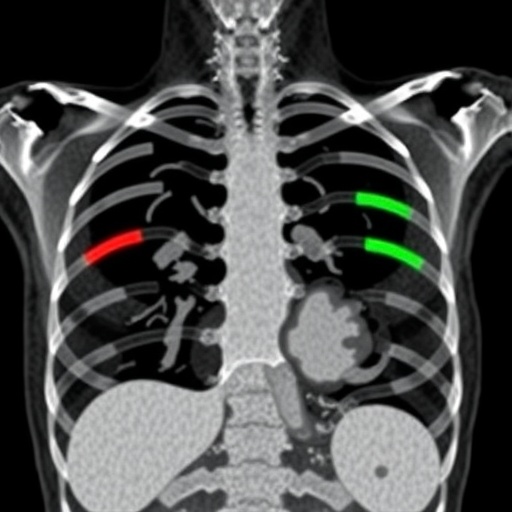In the relentless quest to improve early detection and diagnosis of colorectal cancer (CRC), recent advances have spotlighted the remarkable potential of long noncoding RNAs (lncRNAs) as non-invasive biomarkers. In an expansive meta-analysis published in BioMedical Engineering OnLine, researchers have systematically evaluated the diagnostic accuracy of lncRNAs in CRC, revealing promising performance metrics that could shape future screening modalities and personalized medicine approaches.
Colorectal cancer remains one of the leading causes of cancer-related morbidity and mortality worldwide. The aggressive nature and heterogeneous presentation of CRC pose substantial challenges for timely and accurate diagnosis, often resulting in delayed treatment and poorer prognoses. Conventional diagnostic tools, such as colonoscopy and histopathologic examination, while reliable, are invasive and costly, underscoring an urgent need for sensitive, specific, and minimally invasive biomarkers that can be readily implemented in clinical settings.
Emerging evidence has positioned lncRNAs — RNA molecules exceeding 200 nucleotides that do not code for proteins but regulate gene expression at epigenetic, transcriptional, and post-transcriptional levels — as potentially transformative diagnostic agents. Their aberrant expression patterns have been closely linked to oncogenic pathways in colorectal cancer, yet their broad clinical applicability and efficacy have been variably reported, necessitating rigorous meta-analytic synthesis of existing data to obtain precise estimates of diagnostic performance.
The study in focus undertook a meticulous literature search spanning multiple databases, including Embase, PubMed, CNKI, and Web of Science, encompassing nearly a decade of research from January 2015 to April 2024. A total of 28 eligible studies were integrated into the analysis, collectively assessing the sensitivity and specificity of lncRNAs as CRC biomarkers. This robust sample enabled the investigators to derive pooled diagnostic parameters with enhanced statistical power and reliability.
Results from the meta-analysis demonstrated that lncRNAs possess a pooled sensitivity of 79%, indicating a strong ability to correctly identify patients with CRC. Concurrently, the pooled specificity reached 81%, reflecting a commendable accuracy in correctly discerning individuals without the disease. These metrics are particularly noteworthy, as an ideal diagnostic marker must balance high sensitivity with high specificity to minimize false positives and negatives.
Beyond these fundamental values, the analysis evaluated the positive likelihood ratio (PLR) and negative likelihood ratio (NLR), which quantify how test results influence the odds of disease presence or absence. The pooled PLR of 3.68 suggests that a positive lncRNA test result increases the likelihood of CRC by nearly fourfold, while an NLR of 0.28 indicates a significant reduction in disease probability following a negative test. These ratios illuminate the practical utility of lncRNA assays in clinical decision-making workflows.
The diagnostic odds ratio (DOR), an aggregate measure combining both sensitivity and specificity, was reported as 15.01. This figure provides a consolidated view of test effectiveness, with higher values signifying superior discriminatory power. An impressive diagnostic accuracy was further substantiated by the area under the receiver operating characteristic curve (AUC) of 0.87, signifying excellent differentiation between CRC patients and healthy controls.
Notably, the authors also performed Fagan plot analysis, translating statistical metrics into post-test probabilities that resonate with clinical interpretations. The analysis estimated an 81% probability of disease presence after a positive test and a 20% likelihood post-negative test, illustrating the tangible impact of lncRNA-based diagnostics on patient stratification and management.
To ensure the robustness of their conclusions, the researchers assessed publication bias through Deeks’ funnel plot asymmetry test, which revealed no significant bias affecting the pooled data. This methodological rigor enhances confidence in the validity of the synthesized results and mitigates concerns over selective reporting or study heterogeneity.
Nevertheless, the meta-analysis acknowledged sources of heterogeneity that may influence diagnostic accuracy, highlighting factors such as publication year, sample size, and specimen type. Such variability underscores the complexity inherent in biomarker research and the necessity for standardized protocols in future investigations to optimize reliability and generalizability.
This comprehensive assessment of lncRNAs elevates their status from promising molecular candidates to credible diagnostic tools for colorectal cancer. Given their non-invasive nature—being detectable in body fluids such as blood and stool — lncRNAs open avenues for patient-friendly, cost-effective screening strategies that could complement or even partially replace traditional diagnostics.
Integration of lncRNA-based assays into clinical practice could revolutionize CRC management pathways, enabling earlier detection, personalized risk assessment, and dynamic monitoring of disease progression or therapeutic response. Moreover, the molecular insights gleaned from profiling lncRNAs may illuminate novel therapeutic targets, further intertwining diagnostics and treatment paradigms.
As colorectal cancer burden escalates globally, innovations like these are paramount in shifting the balance towards improved survival and quality of life for affected individuals. The rigorously quantified diagnostic performance of lncRNAs heralds a new frontier in oncology, where molecular signatures guide precise, efficient, and patient-centric care.
Future research endeavors will benefit from expanding sample diversity, refining assay methodologies, and exploring combined biomarker panels incorporating lncRNAs alongside other molecular entities. Such integrative approaches hold promise for elevating diagnostic accuracies beyond current thresholds, fostering a new era of precision oncology.
In conclusion, this landmark meta-analysis crystallizes the diagnostic value of lncRNAs in colorectal cancer, confirming their potential as effective, non-invasive biomarkers. These findings advocate for accelerated translation of lncRNA diagnostics from research settings into routine clinical application, ultimately aiming to improve early detection and patient outcomes in one of the most challenging cancer landscapes.
Subject of Research: Diagnostic accuracy of long noncoding RNAs as biomarkers in colorectal cancer
Article Title: Unveiling the diagnostic power of lncRNAs in colorectal cancer: a meta-analysis
Article References:
Chen, W., Liu, X., Wu, Z. et al. Unveiling the diagnostic power of lncRNAs in colorectal cancer: a meta-analysis. BioMed Eng OnLine 24, 103 (2025). https://doi.org/10.1186/s12938-025-01431-3
Image Credits: AI Generated
DOI: https://doi.org/10.1186/s12938-025-01431-3
Tags: aberrant lncRNA expression patternschallenges in colorectal cancer diagnosiscolorectal cancer morbidity and mortalitycolorectal cancer prognostic indicatorscolorectal cancer screening advancementsearly detection of colorectal cancergene expression regulation in cancerlncRNAs as colorectal cancer biomarkersmeta-analysis of lncRNAs in CRCminimally invasive cancer diagnosticsnon-invasive colorectal cancer diagnosispersonalized medicine in colorectal cancer





